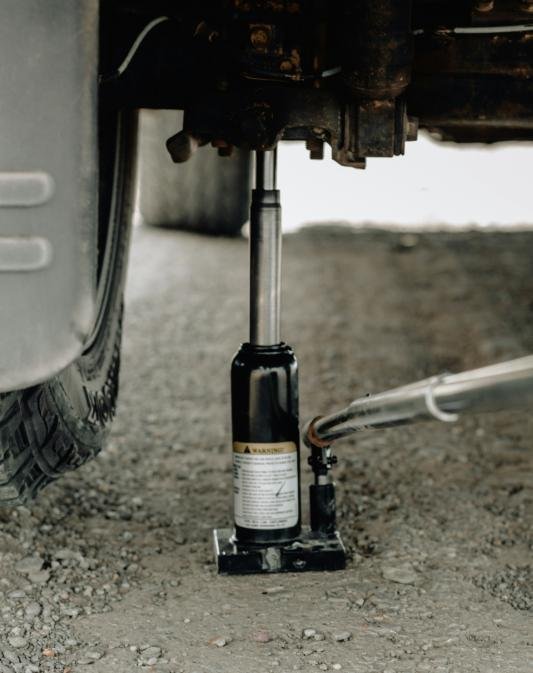Understanding Floor Jacks: What Are They?
A floor jack is an essential tool widely used in the automotive industry for lifting vehicles off the ground to facilitate maintenance and repairs. These hydraulic lifting devices provide a means to safely elevate cars, trucks, and other heavy vehicles in order to access components such as tires, brakes, and exhaust systems. Understanding the functionality and components of floor jacks is crucial for effective use, ensuring both safety and efficiency during automotive tasks.
Floor jacks operate on a hydraulic principle, utilizing fluid mechanics to generate the lifting force needed to raise heavy loads. At the core of this mechanism are several key components: the hydraulic cylinder, the pump handle, a lifting arm, and the saddle, which directly contacts the vehicle. When the pump handle is engaged, hydraulic fluid is drawn into the cylinder, causing the piston to extend and effectively raising the vehicle. This simple yet effective design allows for significant weight capacities compared to traditional mechanical jacks.
There are various types of floor jacks available, each suited to different lifting needs. The most common type is the standard hydraulic floor jack, which is characterized by its wheeled design and ease of maneuverability. Additionally, low-profile jacks are specifically designed for vehicles with limited ground clearance, making them valuable for sports cars. Conversely, there are heavy-duty jacks, often utilized in commercial settings, that can lift even larger vehicles and are built to handle increased stress levels. Understanding the different types and their respective load capacities is important when selecting the appropriate jack for a particular vehicle.
In summary, floor jacks serve a vital role in vehicle maintenance, providing the means necessary to lift automobiles safely and efficiently. Familiarity with their operational principles, types, and components enables users to make informed decisions when utilizing this indispensable tool in automotive care.
Exploring Weight Limitations: What Does 3 Tons Mean?
Understanding the weight capacity of a floor jack is crucial for safe and effective usage, particularly when dealing with heavy vehicles such as trucks. The term “3 tons” specifically refers to the maximum load the jack can handle, which translates to 6,000 pounds (since one ton equals 2,000 pounds). This load limit is vital to ensure that the jack operates within its designed parameters, preventing potential accidents and equipment failure.
When considering whether a 3-ton floor jack can lift a truck, it is essential to take into account the truck’s weight and its distribution. Trucks come in various sizes and configurations, with weight capacities that can easily exceed 6,000 pounds. For example, light-duty trucks may fall within this range, while heavier models and larger commercial vehicles often surpass this weight limit, making them unsuitable for a 3-ton jack.
Moreover, the load capacity of 3 tons is not solely dependent on the truck’s total weight. Factors such as the truck’s weight distribution, the position of the jack, and the surface it is placed on play significant roles in operational feasibility. An uneven or unstable platform can compromise the jack’s support and lead to accidents. It is imperative to employ the jack on a level surface and to utilize jack stands when working under a lifted vehicle to ensure safety.
Ultimately, knowing the weight limitations associated with a 3-ton floor jack allows vehicle owners and technicians to make informed decisions. It enables them to determine not only whether such a jack is suitable for their specific truck model but also to prioritize safety by adhering to established load limits. Understanding these weight parameters ensures that both the jack’s function and the vehicle’s integrity are maintained during maintenance or repair tasks.
Types of Trucks: Assessing Their Weights
When considering the capacity of a 3-ton floor jack, it is essential to categorize the various types of trucks and their corresponding weight ranges. Trucks can be broadly classified into three main categories: light-duty, medium-duty, and heavy-duty. Each category serves different purposes and comes with varying weight specifications that impact the selection of lifting equipment.
Light-duty trucks are typically used for personal or light commercial purposes. These vehicles usually include standard pickups, SUVs, and small vans. The average weight of light-duty trucks generally ranges from 4,000 to 6,000 pounds. As such, a 3-ton floor jack, with a lifting capacity of 6,000 pounds, can safely lift most light-duty trucks without issue.
Medium-duty trucks, on the other hand, are designed for more demanding tasks and often include larger pickups, box trucks, and simple food trucks. The weight of these vehicles typically varies from 6,001 to 14,000 pounds. This means that while a 3-ton floor jack might be suitable for the lower end of this category, it is crucial to assess specific models to determine if they exceed the jack’s safe lifting capability.
Heavy-duty trucks encompass larger commercial vehicles like dump trucks, tow trucks, and tractor trailers. These vehicles can weigh significantly more, often exceeding 14,000 pounds and sometimes reaching upwards of 33,000 pounds or more. Given their considerable weight, it is evident that a 3-ton floor jack would not be adequate for safely lifting heavy-duty trucks. Any lifting attempt in this context might not only compromise the integrity of the jack but also pose serious safety risks for the operator.
In summary, understanding the weight distribution among various truck types is vital for making informed decisions about lifting equipment. A 3-ton floor jack can effectively handle light-duty trucks, might lift some medium-duty variants, but will not suffice for heavy-duty models, necessitating alternative lifting solutions for those vehicles.
The Importance of Safety in Lifting Vehicles
When it comes to lifting vehicles, particularly heavier models like trucks, safety must be the utmost priority. Employing a floor jack for vehicle maintenance or inspection can pose significant risks if certain safety precautions are not observed. The first step in promoting safety is to ensure that the vehicle is parked on a stable, level surface. An uneven or sloped ground can cause the vehicle to shift during the lifting process, increasing the likelihood of accidents.
Additionally, proper placement of the floor jack is critical. It is essential to consult the owner’s manual or manufacturer specifications to determine the appropriate lifting points for the vehicle. Jacks should be positioned directly beneath these points to avoid structural damage, as well as potential instability. Lifting a vehicle without following these guidelines can lead to severe accidents, including the risk of the vehicle collapsing onto the individual operating the jack.
Another important safety measure involves the use of jack stands. While a floor jack can lift a vehicle, it should never be relied upon as the sole support mechanism. Once the vehicle is elevated, jack stands should be placed beneath the vehicle’s chassis to create additional support. This measure is crucial because jacks can fail or slip, especially when dealing with heavier trucks, and jack stands will help mitigate any risk of collapse. Furthermore, individuals should never work underneath a vehicle supported solely by a jack; this poses an unacceptable risk of injury.
Implementing these safety protocols not only protects the individual performing the work but also safeguards bystanders nearby. Adhering to these guidelines whenever operating a floor jack will ensure a safer and more secure environment when lifting vehicles, particularly those with significant weight, such as trucks. Making safety a fundamental principle will contribute to an efficient lifting process and reduce the chances of accidents.
Real-Life Scenarios: When a 3 Ton Jack Works and When It Doesn’t
Utilizing a 3-ton floor jack can be effective in various situations involving truck maintenance and repair, but there are critical factors to consider to ensure safety and efficiency. For instance, consider a standard half-ton pickup truck that weighs around 4,000 to 5,000 pounds. In this case, a 3-ton floor jack would be capable of lifting the vehicle without difficulty, allowing for tire replacements or brake inspections. This scenario reflects the ideal case where the truck’s weight is distributed evenly, and no significant modifications have been made.
However, circumstances change dramatically with trucks that have undergone modifications or carry additional cargo. For example, a modified truck fitted with a heavy-duty lift kit may weigh significantly more than stock configurations, easily surpassing 6,000 pounds. In such scenarios, relying on a 3-ton jack poses serious risks. Attempting to lift a truck exceeding the floor jack’s capacity can result in equipment failure, leading to accidents and injuries. Consumers must assess the total weight, including any added accessories or cargo, as this could push the combined weight of the vehicle beyond safe lifting limits.
Additionally, the load distribution plays an essential role in lifting efficiency. Uneven loads, such as a truck loaded heavily on one side, can complicate the lifting process. If the weight is not centered, a 3-ton jack may struggle to safely lift the vehicle, posing challenges that could lead to dangerous situations. Therefore, evaluating the truck’s weight and balance is paramount when considering the appropriateness of using a 3-ton floor jack for any lifting tasks.
Alternative Solutions for Lifting Heavier Trucks
While a 3-ton floor jack can accommodate a significant range of trucks, its limitations become apparent when faced with heavier models or those that require additional lifting height. For individuals or businesses needing to lift trucks exceeding this weight capacity, several viable alternatives should be considered to ensure safety and effectiveness.
One option is to invest in a hydraulic lift, which generally offers enhanced lifting capacity and stability compared to standard jacks. These hydraulic systems can support much heavier vehicles, making them suitable for larger trucks and heavy-duty applications. Commercial automotive shops frequently utilize hydraulic lifts, allowing mechanics the flexibility to work underneath vehicles easily. The investment in a hydraulic lift can be more substantial; however, it pays off in versatility and safety for frequent use.
Another consideration is a larger capacity floor jack. Jacks are available in various capacities, often exceeding the 3-ton specification. These jacks are constructed with sturdier materials and a robust design to handle increased weight. When selecting a large capacity jack, users should evaluate both the weight limit and any additional features, such as a wide lifting range and enhanced stability, to ensure optimal performance.
Additionally, enlisting professional services might be the most pragmatic solution for those who rarely need to lift heavy trucks. Automotive service centers are equipped with specialized equipment and trained personnel capable of handling these larger vehicles safely and efficiently, reducing the risk associated with improper lifting techniques.
Ultimately, understanding one’s specific lifting needs and considering the available alternatives can lead to informed decisions, ensuring safety and efficiency in lifting operations, particularly for heavier trucks. By evaluating these options, individuals can invest in the most suitable equipment or services based on their requirements.
User Recommendations: Choosing the Right Floor Jack for Your Needs
When selecting a floor jack, particularly if the intention is to lift heavier vehicles such as trucks, several critical factors must be taken into consideration to ensure safety and efficiency. The primary concern should be weight capacity; a floor jack’s capacity is the maximum weight it can safely lift. For lifting trucks, a 3-ton floor jack is often suitable, but it is important to verify the vehicle’s weight to avoid overloading.
Another important aspect to evaluate is the jack height, which refers to the minimum and maximum lifting height the jack can achieve. It is vital to select a jack that not only meets the vehicle’s ground clearance but also provides adequate lifting height for tasks such as tire changes or inspections. If a vehicle has low clearance, a low-profile jack may be necessary. Conversely, for taller trucks, a standard height jack would likely be the better option.
Construction quality is equally essential. A floor jack made from high-grade materials typically offers better durability and support, ensuring it can safely hold the weight of a truck. Look for features such as a wide base for stability, reinforced lift arms, and a safety valve to prevent over-extension. Additionally, research the warranty and brand reputation to gauge reliability.
Lastly, price considerations should align with your lifting needs and budget. While more affordable options may seem appealing, investing in a higher quality jack usually leads to greater reliability and longevity. It is advisable to balance cost against function to make an informed decision.
Maintenance Tips for Your Floor Jack
Regular maintenance of your floor jack is essential for ensuring safety and prolonging its lifespan. By adhering to a routine maintenance schedule, users can significantly reduce the risk of malfunctions while ensuring efficient performance. One of the foremost maintenance tasks involves cleaning the floor jack after every use. Debris, oil, and dirt can accumulate on the surfaces and within the hydraulic components, potentially hindering the operation. Utilizing a clean cloth and a suitable cleaner, it is advisable to wipe down all parts meticulously, ensuring no contaminants remain on the jack.
Inspection for wear and tear is another critical aspect of maintenance. Users should routinely check the hydraulic fluid level; insufficient fluid can cause the jack to fail under load. Inspect the seals for any signs of leaks, as well, since hydraulic fluid leakage can severely compromise functionality. Additionally, checking the integrity of the lifting arm and the wheels is vital. Any bends, cracks, or excessive wear can signal a need for replacement or professional servicing.
Proper storage of a floor jack is equally important. Storing the jack in a dry and clean environment protects it from rust and other environmental factors that could lead to deterioration. Ensure that the jack’s safety mechanism is functioning correctly, allowing for safe operation during lifting tasks. Furthermore, familiarizing oneself with basic troubleshooting techniques can immensely benefit users. For instance, if the jack fails to lift, checking for fluid levels and inspecting for air within the hydraulic system can offer insights into potential issues. By establishing a consistent maintenance routine, users can optimize the performance of their floor jack and ensure it remains a reliable tool for lifting heavy loads, whether working on a truck or another vehicle.
Conclusion: Final Thoughts on Using a 3 Ton Floor Jack for Trucks
In summary, the use of a 3-ton floor jack for lifting trucks entails a careful consideration of various factors, particularly load capacities and safety protocols. As highlighted throughout the discussion, understanding the weight of your specific truck model is paramount, as exceeding the load capacity of a jack can lead to dangerous situations. Trucks vary significantly in weight; for instance, lighter models may sit comfortably within the 3-ton limit, while heavier options may necessitate a jack with a greater load capacity.
Additionally, safety is a critical aspect that cannot be overlooked. When using a 3-ton floor jack, ensuring that it is on stable, level ground is essential to prevent slips or accidents while lifting. Utilizing jack stands for extra support is highly recommended, as relying solely on the jack can pose risks once the truck is elevated. Understanding the lift points specified by the manufacturer is also crucial to avoid damage to the vehicle and ensure safe lifting practices.
Moreover, it is beneficial to familiarize oneself with the specific features of the jack being used, including its range of motion, grip, and any safety locks it may have. This knowledge enhances user confidence and promotes mindful operation. For those regularly involved in lifting trucks, investing in higher-capacity jacks may be prudent to accommodate a wider variety of truck sizes and models.
Ultimately, a well-informed decision regarding the use of a 3-ton floor jack not only contributes to effective truck maintenance but also prioritizes the safety of the user. By adhering to the outlined considerations, individuals can effectively utilize a 3-ton floor jack while minimizing risks associated with lifting heavy loads.








